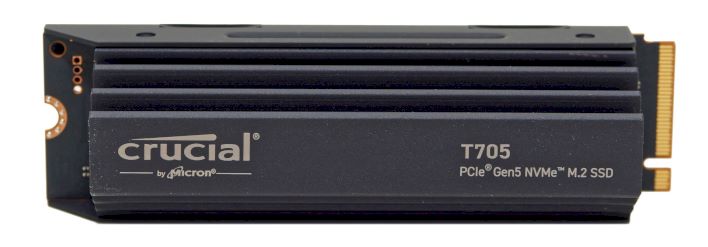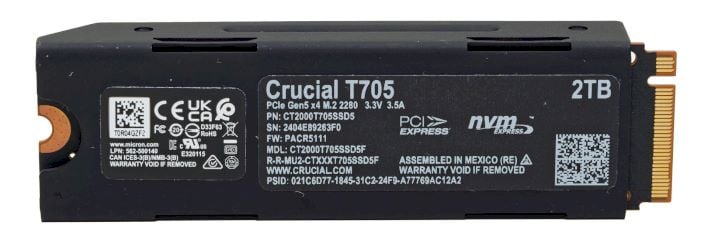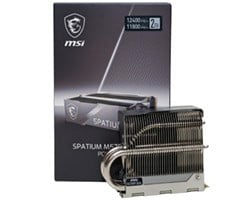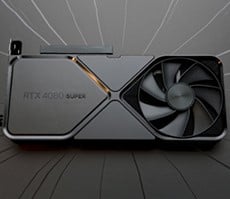Crucial T705 SSD Review: The Fastest PCIe Gen 5 SSD We've Tested
| Crucial T705: MSRP 2TB for $399, With Heatsink $439 The Crucial T705 NVMe SSD packs Micron's latest NAND flash memory, fresh firmware tweaks, and Phison's E26 controller, to offer class-leading performance.
|
|||

|

 |
||
Main features and specifications are up first, then we’ll get down to the business of benchmarking...
Crucial T705 SSD Specifications And Features
Crucial T705 Gen5 SSD Highlights
|
Advanced Features
|
Micron will be offering the Crucial T705 in three capacities and three trims. The drives will be available in 1TB, 2TB, and 4TB capacities, and will be sold either with or without an included heatsink. A white, Special Edition 2TB model will also be made available in limited quantities. We’ve got a 2TB drive with heatsink on hand for testing here, which is what you see pictured below.
Note, that the actual drives being sold are the same; Crucial T705s with or without heatsink are identical. Micron is simply offering the Crucial T705 in multiple flavors to account for the widest breadth of system configurations. If your motherboard’s got built-in cooling hardware for its M.2 slots, there’s no need to buy an SSD with an included heatsink.
That said, we should point out that some sort of cooling is absolutely required for these drives. The non-heatsink model will technically operate without added cooling, but under sustained loads, it will heat up quickly, throttle and potentially throw errors. As such, they're not suitable for the PS5.
Other than its cooling hardware, the Crucial T705 looks just like the vast majority of high-end M.2 SSDs currently on the market. The drives use the common M.2 2280 form factor and feature dark-colored PCBs with both sides of the board populated with an array of components (at least on the 2TB model we evaluated).
The foundation of the Crucial T705 is an 8-channel Phison PS5026-E26 controller, which is paired to some of Micron’s own 232-Layer B58R 3D TLC NAND Flash memory operating at 2,400MT/s, in addition to few pieces of LPDDR4 DRAM cache (1GB per 1TB of capacity), and customized Micron/Crucial firmware.
Phison PS5026-E26-based drives have evolved quite a bit since they were first introduced, thanks in part to Micron. Early drives based on the Phison PS5026-E26 shipped with Micron’s B58R 3-bit per cell (TLC) NAND memory running at 1,600MT/s. Those drives typically hit transfer rates of about 10GB/s, which was marginally faster than the best PCIe 4.0 SSDs available at the time. Later Micron released a B58R variant running at 2,000MT/s, which pushed performance to about 12GB/s. This time around, Micron B58R running at 2,400MT/s, pushes the limits of Phison’s controller and ups peak theoretical transfers to about 14.6GB/s. The combination of the Phison PS5026-E26, another year’s worth of firmware and power optimizations, and 2,400MT/s B58R is what Phison was had branded “Max14um”, at CES earlier this year.
Other features of the Crucial T705 drives include the aforementioned PCIe Gen x4 (Gen 5) interface, TRIM and active garbage collection, support for the NVMe 2.0 specification, ECC, and built-in AES256 encryption with TCG Opal 2.01 support.
Performance of the Crucial T705 will vary somewhat depending on the capacity of the drive being tested. We are looking at a 2TB drive here, which Crucial rates for up to 14,500 / 12,700MB per second reads and writes, respectively, with up to 1.55M / 1.8M read and write IOPS, respectively. Endurance for the 2TB drive we have here is rated for 1200TBW (1.2PBW), though that number scales upward or downward depending on the total capacity. Micron also backs the drives with a full, five year warranty.
The specs for the Crucial T705 look great, but all those numbers don’t mean much if its actual performance doesn’t match-up, so let’s get to some benchmarks...
Crucial T705 SSD SSD Benchmarks
Under each test condition, the SSDs showcased here were installed as secondary volumes in our testbed, with a separate drive used for the OS and benchmark installations. Our testbed's motherboard was updated with the latest BIOS available at the time of publication and Windows 11 was fully updated. Windows Firewall, automatic updates, and screen savers were all disabled before testing, and Focus Assist was enabled to prevent any interruptions.
In all test runs, we rebooted the system, ensured all temp and prefetch data was purged, and waited several minutes for drive activity to settle and for the system to reach an idle state before invoking a test. All of the drives here have also been updated to their latest firmware as of press time. Where applicable, we would also typically use any proprietary NVMe drivers available from a given manufacturer. When not available, the drives used the Microsoft driver included with Windows 11.HotHardware's Test System:
| Processor: Intel Core i9-13900K Motherboard: MSI Z790 Godlike Video Card: GeForce RTX 3080 Memory: 32GB Micron DDR5-6000 Storage: ADATA XPG GAMMIX S70 Blade (OS Drive) Seagate FireCuda 540 (2TB) ADATA Legend 970 (1TB) Samsung SSD 990 Pro (2TB) Crucial T700 (2TB) MSI Spatium M570 Pro (2TB) Crucial T705 (2TB) |
OS: Windows 11 Pro x64 Chipset Drivers: Intel v10.1.19284 Benchmarks: IOMeter 1.1 HD Tune v5.75 ATTO v4.01.01f AS SSD SiSoftware SANDRA CrystalDiskMark v8.0.4c x64 Final Fantasy XIV: Endwalker PCMark 10 Storage Bench 3DMark Storage Tests |
IOMeter Benchmarks
IOMeter is a well-respected industry standard benchmark. However, despite our results with IOMeter scaling as expected, it is debatable as to whether or not certain access patterns actually provide a valid example of real-world performance. The access patterns we tested may not reflect your particular workloads, for example. That said, we do think IOMeter is a reliable gauge for relative throughput, latency, and bandwidth with a given storage solution. In addition, there are certain highly-strenuous workloads you can place on a drive with IOMeter that you can't with most other storage benchmark tools.In the following tables, we're showing two sets of access patterns; a custom Workstation pattern, with an 8K transfer size, consisting of 80% reads (20% writes) and 80% random (20% sequential) access and a 4K access pattern with a 4K transfer size, comprised of 67% reads (33% writes) and 100% random access. Queue depths from 1 to 16 were tested...


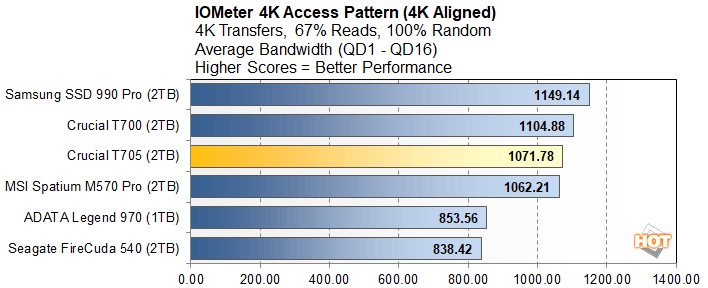
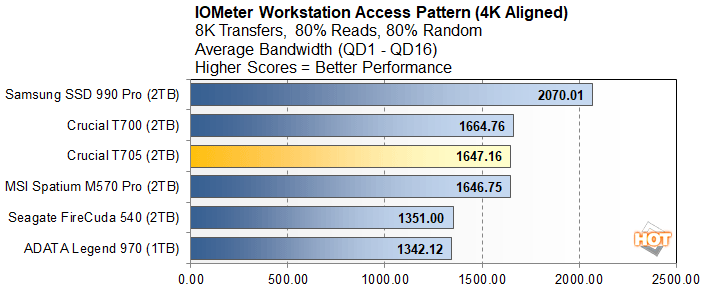


In terms of latency, as reported by IOMeter with the access patterns we tested, we see more of the same. All of these drives are very fast relative to lower-end drives currently on the market, nevertheless, the Crucial and MSI drives perform similarly here, while the Samsung drives pulls ahead.
SiSoft SANDRA 2022

ATTO Disk Benchmark
ATTO is another "quick and dirty" type of disk benchmark that measures transfer speeds across a specific volume length. It measures raw transfer rates for both reads and writes and graphs them out in an easily interpreted chart. We chose .5KB through 64MB transfer sizes and a queue depth of 6 over a total max volume length of 256MB. ATTO's workloads are sequential in nature and measure raw bandwidth, rather than I/O response time, access latency, etc.


Save for a couple spots with the smaller transfer sizes, the Crucial T705 lead the pack in terms of both read and write throughput. Writes were only marginally faster than the T700 and MSI Spatium M570 Pro, but reads were much better for the Crucial T705 and peaked at about 13.5GB/s.


The Crucial T705 and MSI Spatium M570 Pro performed almost identically in terms of IOs, according to ATTO, save for the 32K transfer size in the read test, where the Crucial drive pulled ahead.
AS SSD Compression Benchmark
Next up we ran the Compression Benchmark built-into AS SSD, an SSD specific benchmark being developed by Alex Intelligent Software. This test is interesting because it uses a mix of compressible and non-compressible data and outputs both Read and Write throughput of the drive. We only graphed a small fraction of the data (1% compressible, 50% compressible, and 100% compressible), but the trend is representative of the benchmark’s complete results.




